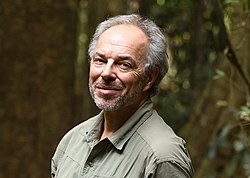Carl Safina | |
|---|---|
 | |
| Born | May 23, 1955 Brooklyn, New York, U.S. |
| Occupation | Author, Professor, Founder of SafinaCenter.org |
| Language | American English |
| Alma mater | B.A. State University of New York at Purchase M.S. Rutgers University Ph.D. Rutgers University |
| Period | 1990– |
| Subject | Ecology |
| Notable works | Song for the Blue Ocean Eye of the Albatross Voyage of the Turtle Nina Delmar and the Great Whale Rescue The View from Lazy Point A Sea in Flames Beyond Words: What Animals Think and Feel Becoming Wild Alfie and Me |
| Notable awards | MacArthur Fellowship Guggenheim Fellowship Pew Fellowship John Burroughs Medal George B. Rabb Conservation Medal James Beard Medal Orion Book Award Lannan Literary Award |
| Spouse | Patricia Paladines |
| Website | |
| carlsafina | |
Carl Safina (born May 23, 1955) is an American ecologist and author of books and other writings about the human relationship with the natural world. His books include Becoming Wild: How Animal Cultures Raise Families, Create Beauty, and Achieve Peace; Beyond Words: What Animals Think and Feel; Song for the Blue Ocean; Eye of the Albatross; The View From Lazy Point: A Natural Year in an Unnatural World; Alfie and Me; and others. He is the founding president of the Safina Center, and is inaugural holder of the Carl Safina Endowed Chair for Nature and Humanity at Stony Brook University. Safina hosted the PBS series Saving the Ocean with Carl Safina.